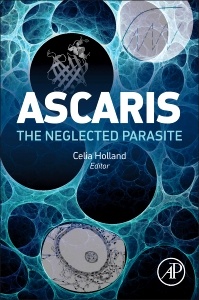Ascaris The Neglected Parasite
Coordonnateur : Holland Celia

1. Immunology of Ascaris and immunomodulation
2. Ascaris and allergy
3. The significance of ABA-1
4. Implications of co-infection with Ascaris
Section II: Model systems
5. The use of the mouse model to explore the role of the liver in susceptibility and resistance to Ascaris
6. Unique attributes of Ascaris as a model system: Neurobiology
Section III: Epidemiology of ascariasis
7. Ascaris lumbricoides: new epidemiological insights and mathematical approaches
8. Genetic epidemiology of Ascaris
9. Mathematical Modeling
Section IV. Host and parasite genetics
10. New insights into evolutionary-history and phylogeography of Ascaris
11. Ascaris genomics
12. Human host susceptibility to ascariasis
Section V. Clinical aspects and public health
13. The extent of the problem: numbers and impact (Ascaris lumbricoides)
14. Impact of Ascaris suum in livestock
15. Approaches to control of STHs including ascariasis
16. Diagnosis and control of Ascaris suum
Professor Holland is an Invited Expert on the WHO Advisory Panel on Parasitic Diseases and currently Secretary General of the European Federation of Parasitology. She is an Editor of the journal Parasitology (CUP). She was previously President and Secretary of the Irish Society for Parasitology. Author of over 100 publications including peer-reviewed journal articles, books, and book chapters on parasitology and related topics; including the senior editorship of “Toxocara the enigmatic parasite and “The Geohelminths: Ascaris, Trichuris and Hookworm as part of the World Class Parasites series.
- Brings together a wide range of topics and approaches and recent, comprehensive and progressive research concerning the neglected parasite Ascaris
- Provides a blueprint of how a single parasite entity can stimulate interest in basic biology, clinical science, veterinary science, public health and epidemiology
- Presents a wealth of new insights given that a book on this parasite has not been published for over 20 years
- 16 chapters from a range of top authors from around the world
Date de parution : 08-2013
Ouvrage de 460 p.
15x22.8 cm
Thèmes d’Ascaris :
Mots-clés :
ABA-1; As-p18; Ascariasis; Ascaris suum; C57BL/6j; CBA/Ca; DNA barcoding; FMRFamide-like peptide; G-protein coupled receptor; IgE; Th1; Th2; allergens; allergy; anthelmintic; anthelmintics; antigen polymorphism; ascariasis; asthma; atopy; bioinformatics; bounce-back times; clinical disease; clinical effects; co-infection; control; cytokines; density dependence; diagnosis; diagnostic methods; disability-adjusted life years; disease; disease burden; drug efficacy; drug targets; effective population size; electrophysiology; evolution; experimental infections; farm management; gastrointestinal tract; genome; hepatic immunology; hepatitis; heritability; heterogeneity; host genetic factors; human immunodeficiency virus; humans; hybridization; immune response; immunobiology; immunogenetics; immunomodulation; immunoregulatory; inbred mouse strains; landscape genetics; larval migration; ligand-gated chloride channel; ligand-gated ion channel; liver; localized infection; lungs; malaria; mass drug administration; massively parallel sequencing; mathematical modeling; mathematical models; milk spots; molecular epidemiology; monitoring and evaluation; mortality; neuromodulator; neuropeptide; neuropeptide-like protein; neurotransmitter; numbers infected; parasite; parasite genotypes; pathogenicity; pathology; pedigree analysis; phylogenetics; pigs; population dynamics; population genetics; preventive chemotherapy; protein structure; quantitative trait locus (QTL); reproduction number; reservoir hosts; resistance/susceptibility; respiratory syncytial virus; school-based de-worming; soil-transmitted helminths; statistical models; systemic infection; taxonomy; transcriptome; transmission; transmission dynamics; transmission limits; treatment; treatment effects; tuberculosis; vaccination; white spot formation



